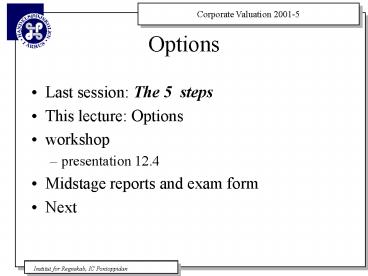Options
1 / 12
Title: Options
1
Options
- Last session The 5 steps
- This lecture Options
- workshop
- presentation 12.4
- Midstage reports and exam form
- Next
2
CMK.20 Options
- If investors were riskneutral we could discount
risky cashflow using the riskfree rate, but they
are not ! - Hence risky inflows minus certain outflows (NPV)
does not work - if you use risk-adjusted probabilities you can
discount using the risk free rate, alternatively
discount using a risk adjusted interest rate, but - NPV assumes constant risk i.e. a passive
management in a static world !
3
CMK.20 Options
- Decision Tree Analysis decides AFTER information
is received (ctr. event tree) but what discount
rate to use ? - there is no single, constant discount rate
because it changes with time (info) and
underlying conditions (risk) - Options are truely dymanic and find their
discount rate in a comparable security - the risk on an option on an underlying risky
asset is always greater than the risk on the
asset - hence DTA uses too low an interest rate giving
too high value estimates
4
CMK.20 Options
- Options takes care of flexibility and of
uncertainty that is gradually solved over time.
They presume decisiontaking in the future,
contingent on the arrival of new information and
learning, not now - based on expectations of
future informations - operating real option is the value of flexibility
- growth option is the value of sequential
interdependency - there are asset options and liability options
e.g.
5
CMK.20 Options
- Options to
- abandon (put) resale /liquidation value
- defer (call) development costs
- expand (call) expansion costs
- contract (put) contraction costs
- switch (putts and calls) restruc Shutdown c.
- non ordinary equity
- lease
- Of value when
- uncertainty is high
- adaptiveness is high see exh.20.1
6
CMK.20 Options
- Exhibit 20.4
- NPV -6,5 - without flexibility
- DTA 23,4 - with flexibility
- the value of the option can be approximated to
the diff. 29,6 - the true optionvalue calculated on a twinn
security gives an option value of 20,9 6,5
27,4
7
6 optionvalue drivers
8
CMK.20 Options
- Event tree (no flexibility) models the evolution
of uncertainty in the different possible NPV
events over time. Use expected values risk
adjusted interest rates OR risk adjusted
probabilities risk free rate - Decision tree (with flexibility) have decision
nodes added and hence improves the positive
value path in the event tree - 4 steps in option evaluation(exh.20.10)
- base case without uncertainty and flexibility,
using DCF - event tree with uncertainty, but still no flex.
(use objective probabilities and WACC) - use flexibility in a decision tree analysis
- calculate option value (evt.using option risk
rate)
9
Luehrman Investment opportunities
- The correspondance between project
characteristics and the option value drivers
shows us, that deferral has two value elements
to be included - earning the timevalue of money on the postponed
exercise price X, (X-PV(X)) - the world may change/ is uncertain
- ad1. NPV S-X where S is stock value
- modifiedNPV S-X(X-PV(X))S-PV(X)
- converted to a ratio to handle it easier
NPVqS/PV(X) - ad2. Measure uncertainty by assessing probability
and let the option-pricing model quantify the
value. The measure is cumulative variance in
returns but we utilize the square root of this
called cumulative volatility
10
Luehrman Investment opportunities
- These two metrics combine the 5 option variables
into two dimensions (see p.55) called Option
space - Option space is priced via a table (see p.56)
- How to do in 7 steps (p.58)
11
Luehrman Strategy as options
- Use the two option value metrics ( NPVq and
cumulative volatility) to locate the project in
the option space to obtain the effect of
uncertainty and active decision making - The tomato garden metaphor divides the garden in
6 regions, giving us 6 possible actions instead
of just two (invest/ not invest) - also taking
the likelihood of the projekcts future attraction
into consideration. - Never (6) and Now (1) combined with sure, maybe,
and probable. (se p.94). - This is a dynamic approach where time moves the
opportunity upwarrd and to the left, and active
management can move it back
12
Kasanen Trigeorgis
- Strategic investment planning
- how to design proper controls consistent with the
value-max strategy - to create and manage a collection of
opportunities giving a growth path (strategic
investment mix)- controlled via ROA and growth. - 3 strategic sources of value
- flexibility (operating real options)
- synergy between projects
- sequential project interdependencies (growth
options)































